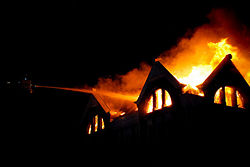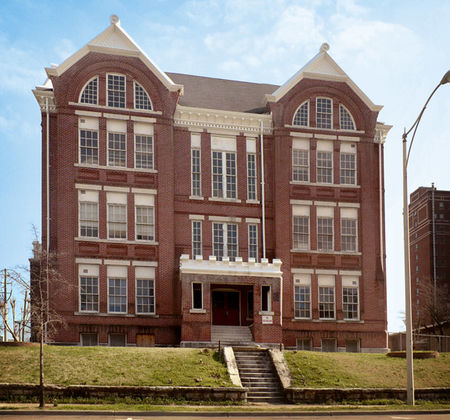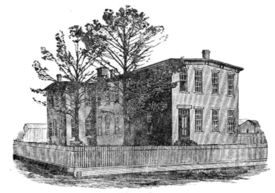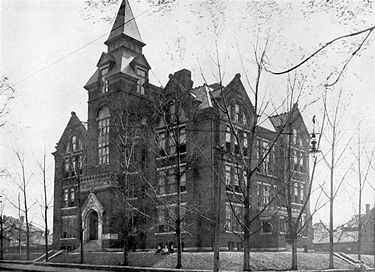Powell School
The Powell School (originally the Free School) is the oldest surviving school in the Birmingham City Schools system. Although the current building was constructed in 1888, the school's history stretches back to the first school constructed on the site on the northeast corner of Block 51, southwest of the intersection of 24th Street and 6th Avenue North, in 1874.
Powell School closed in 2001 and was used for some time as a teaching laboratory. Although the city had made proposals to redevelop the property for educational purposes, the 16,944 square-foot building was still vacant when it caught fire on the evening of January 7, 2011.
History
In early 1873 a group of citizens approached Colonel John T. Terry for help in establishing a free school to attract residents to return to the struggling new city. He, in turn, approached James Powell, president of the Elyton Land Company, and secured the use of a 100 by 190 foot lot, donated to the city on June 21, 1873, given "for the purpose of a free school for white children now residing in, and may reside hereafter in said city or within one-half mile of the limits of said city, and for no other purpose whatever. The school to be taught by white teachers."1.. Donated by trust, if the land were ever used for another purpose, the title would revert back to the Elyton Company or its successors.
Though many complained that the site was too far "out in the country", it was accepted and Terry and Charles Linn began raising funds to build a schoolhouse. Powell donated a large sum, but ultimately the city took out its first bond issue for $3,000, all of which were bought by Terry. After he was elected Mayor, Powell turned over his salary as Mayor of Birmingham ($1,330 per year) for the school's use, along with all fines collected through the Birmingham Police Court. One legend holds that he put up a suit of clothes as collateral for a second loan in order to cover the $4,795 needed to complete construction. In appreciation, the children of the school later presented Powell with a tailored suit of clothes.
The four-classroom brick school building was dedicated on March 1, 1874 and opened on Monday, April 20 of that year, with D. C. B. Connelly as principal. On the first day, 190 students enrolled, with another 40 appearing the following day for a total of 230. The school was divided into four classes, led by Mr Grace, Mr McLaughlin, Mrs Thomas and Mary Cahalan. Plans to add a fifth classroom were begun immediately.2. Terry served on the Board of Trustees along with George Thomas and J. J. Jolly.
Fees of about $1.50 per year were charged initially to help pay down debts, but the amount was reduced gradually and the "free school" eventually dropped the fees altogether through the 8th grade. It remained the only public school in the city until 1883, at which time other schools for lower grades were built and it became a high school. In that year John H. Phillips was hired as superintendent to modernize the city's educational efforts. He assigned each pupil a number, by which they were addressed in class3..
The following year the Birmingham Board of Education was created to take over school operations from the Mayor and Board of Aldermen. Powell graduated its first senior class in 1885, with commencement exercises at O'Brien's Opera House.
Samuel Earle was one of those first students and remembered taking recess at "The Grove" which became East Park. He recalled throwing sticks into a bottomless sinkhole, hoping that they would float down the underground river and pop up at Elyton Spring. He also recalled George Ward's handsome lettering in his copybook and Goerge Hays winning a "most gentlemanly-student" competition sponsored by merchant A. B. Vandergrift4.
New building
In 1886 the original school building was damaged by fire and declared unsafe. Plans were made for a new 15-classroom structure on the same site. A $50,000 bond issue was drafted and an adjoining 50-foot lot was purchased. During construction, classes met at first in the Exposition Building on Capitol Park, then moved again to the Wright Building at 19th Street and 3rd Avenue North.
The new school building was completed and opened on 1888. It housed the lower grades while the high school students continued attending classes in the Wright Building.
The new facility was considered "the most modern and the best equipped elementary school in the South" at the time5. The brick exterior was crowned by a series of stone gables. A central hexagonal room on each floor serves as an office while each classroom has large triple windows on two sides. It was named Powell School to honor Colonel Powell at Colonel Terry's suggestion. Mary Cahalan was named as the first principal of the new school.
In 1890 the high school students moved out of the Powell School and met in the Enslen Building on the site later occupied by the Ridgely Apartments (now the Tutwiler Hotel).
A School Building Survey conducted in 1923 by the Board of Education described the obsolescence of the thirty-five year old facility, which then accommodated an enrollment of 667: "This building is one of the oldest in Birmingham, and, therefore, of an obsolete type and not planned for present-day use. It is, however, in better condition than many of the later ones. It is a pure class room school consisting of 12 rooms and is badly over-crowded. The 18 square feet per pupil of playground space is inadequate but the city park (East Park) in close proximity affords additional play space." 6.
The study recommended adding two classrooms, a large gymnasium, a small auditorium, a kindergarten, a room for nature study, a music room, two home-economic rooms, two manual training shops, a library and accessory rooms.7.
Addition
In 1941, following a fire at the Barker School in Druid Hills, Henley School PTA president Harry Singler labelled Henley and Powell Schools as "firetraps" and suggested that the board tear them down and replace all three with a single, modern combined school in a central location, presumably downtown near the existing Powell School site. Some parents of children that attended Barker resisted the idea of sharing a new school with children from the newly-opened Central City Housing Project, expressing concern over the risk of students having to cross the railroad tracks on 10th Avenue North8.. Parent Oliver Steele added that "downtown property isn't going to be worth a dime in a few years. It'll be just parking lots," and demanded that Barker be replaced on its previous site9.
With $10,000 from a $7,000,000 bond issue passed in November 1945 a 50 by 190 foot lot adjacent to the school was purchased from three daughters of T. D. and Sarah Bradford, two of whom taught in city schools. Another 50-foot lot had already been acquired. The planned addition, housing a lunchroom, auditorium and boiler as well as classroom space for 52 additional pupils, was completed in 1951. At the same time the stairways in the older building were fireproofed and the lighting modernized. The cost was estimated at about $120,000.10.
The city's first classes for vision-impaired students were pioneered at Powell School. In the program disabled students would spend part of the day working with their own teachers in a dedicated resource room, but would join their sighted classmates for the remainder of the day, reading from braille editions of the same texts.
Renovations
In the 1960s there was talk of tearing down the old building, which was showing obvious signs of disrepair, but preservationists carried the day and in the summer of 1969 the brick exterior was sandblasted and the joints "rechinked" with new white mortar using $56,750 of state bond funds9.. In 1974 the building's future was again imperiled by the likelihood that most of its students would be relocated for the construction of the Red Mountain Expressway. Principal Gordon Starr made plans to convert one main-level classroom into a museum of education history in order to preserve the usefulness of the building11.. In 1976 Powell School was added to the National Register of Historic Places.

In November 1980, fearing for the structural stability of the old building, Superintendent Wilmer Cody ordered classes moved to Phillips High School while a structural evaluation was undertaken. At the time, school board president Bettye Fine Collins indicated that the system would be better off ridding itself of an old structure requiring costly repairs. With help from the Birmingham Historical Society the Board won a grant from the Alabama Historical Commission to assist with repairs. In December the Board accepted a bid from the Sun Building Company which was expected to make the building "safe for another 50 years."
In the late 1980s, then-principal Eva Hardy Jones convinced the school board to purchase and renovate an adjacent Trailways Bus Station as a gymnasium. It was dedicated as the Eva Hardy Jones Annex on October 31, 1993.
Closure
Until 2002 the Powell School operated as Powell Elementary School. Enrollment had dropped by about half with the redevelopment of the nearby Metropolitan Gardens housing project. The decision to close down the school was included in the Birmingham Board of Education's Capital Improvement Project, approved in 2001. After the end of the 2001-2002 school year, the building was closed and plans were made to convert it into a teaching laboratory and historical archive, possibly including exhibits open to the public. The next fall, classes resumed in a renovated section of nearby Phillips High School.
In 2006, a "Community Partnership for the Future of Phillips & Powell" began meeting to discuss the future of the buildings and educational opportunities for area students. The Birmingham-Jefferson Historical Society considered the building for its planned Birmingham History Center, but determined it would be too expensive to renovate. In 2008 Birmingham mayor Larry Langford proposed refurbishing Powell School as an adult education center. He requested that the Board turn the property over to the City of Birmingham in partial fulfillment of an incomplete April 2007 agreement in which the city gave the system $3 million to fund teacher buyouts. On October 29, 2008 the Board agreed to hand over titles to four former school properties: Carver, Banks, Elyton and Powell Schools. Board member Virginia Volker voted against the motion, voicing concern for the historical preservation of the Powell School building.
In 2009, Langford suggested donating the building to the private Cornerstone School, but no progress was made on that proposal.
Fire and subsequent developments
The school building erupted in fire on January 7, 2011. The blaze apparently began on the third-floor. It was reported shortly after 9:00 PM. Efforts to battle the blaze were frustrated by gusting winds, but the Birmingham Fire and Rescue Service was able to bring the fire under control by 10:30. The roof and upper floor collapsed into the building. An analysis of the structural condition of the school was begun shortly afterward, with some hope being held out that the exterior shell could be stabilized.
Following the fire, there was some controversy over the ownership of the property. Because it was no longer being used as a school, Barber Companies, successors to the Elyton Land Company, initially argued that the title should have reverted to them. The city, in possession of the original hand-written deed, began a legal review. Before the end of the month, however, Barber signed a quit-claim deed, establishing the city's ownership. Meanwhile, it was found that the Board of Education no longer carried insurance on the building, and the city's policy would provide only $350,000 toward repairs.
In February, an inspector with Traveler's Insurance informed the city that the building is not structurally sound enough to be saved. Attorney Sam Frazier commissioned a separate report. Mayor Bell agreed that the city would wait six months for a viable rehabilitation proposal before proceeding with demolition. In May, the city council gave the Alabama Trust for Historic Preservation 6 months to come up with a viable plan to save the building, offering the $500,000 insurance payment as seed money for preservation. If no plan were presented, the city would move forward with demolition. A formal agreement was signed to that effect on July 19, 2011.
The Trust placed the structure on its 2011 "Places in Peril" list and contracted Meredith Environmental of Sylvan Springs to perform preliminary stabilization and environmental assessment. KPS Group and Hoar Construction have volunteered to donate services for studying potential adaptive re-use of the structure.
In February 2012 the Trust erected a large "For Sale" sign on the property to enhance marketing efforts. In October of that year, the Birmingham Design Review Committee approved plans to use the insurance settlement to construct a new roof to protect the rest of the building while negotiations with potential development partners continued.
In October 2013 the Trust announced that Integral Group, LLC of Atlanta, Georgia, a developer of the Park Place Hope VI mixed-income community surrounding the school, had purchased the building to divide into apartments. Their project moved forward in 2015 when it was awarded a $3.7 million loan from the U.S. Department of Housing and Urban Development's Section 108 Loan Guarantee Program. Williams Blackstock Architects and Christy Cobb Inc. engineers provided design services. In the following decade, no redevelopment project was ever pursued, and the building has suffered significant additional damage from weathering.
In February 2023 the City Council's Economic Development & Tourism Committee recommended terminating the city's redevelopment agreement with the Trust and its associated deed restrictions, in order to be able move forward with a joint proposal by Harbert Realty Services, Sloss Real Estate and Stewart Perry Construction to create a redevelopment plan. The new agreement, under which the sale of the property to Stewart Perry, includes language that the developer will not come back to the city for any additional financial incentives related to the project.
Principals
|
|
Notes
|
1. Birmingham News, May 20, 1954 |
5. Birmingham Post-Herald, August 22, 1969 |
9. Birmingham Post, March 25, 1941 |
References
- Birmingham Iron Age (April 23, 1874), quoted in "Eklektikós" (July 1977) Journal of the Birmingham Historical Society, Vol. 5, No. 2, p. 26
- Cruikshank, George M. (1920) History of Birmingham and Its Environs (2 vol.) Chicago: Lewis Publishing
- Birmingham Board of Education (1923) The Birmingham School Survey. Birmingham: Birmingham Board of Education
- "Powell, first public school in this city rich in history of trials of education" (June 17, 1928) Birmingham Age-Herald
- "Fifty Years Ago Teachers Called Birmingham School Kids By Number." (September 24, 1932) Birmingham Post
- "'Henley And Powell Are Firetraps' (March 25, 1941) Birmingham Post
- "Parents Reject School Combine" (March 25, 1941) Birmingham Age-Herald - via Birmingham Public Library Digital Collections
- "Lot is bought for expanding Powell School (May 30, 1946) Birmingham Post
- "Powell School property deeded to city in 1873 for white use only." (May 20, 1954) The Birmingham News
- Waddle, Chris (August 22, 1969) "Powell School's Face-Lifting Now Complete." Birmingham Post-Herald
- "Powell centennial brings memories of days long gone" (February 21, 1972) Birmingham Post-Herald
- Kennedy, Harold (July 11, 1974) "Historic school in peril of expressway routing." The Birmingham News
- "Powell's students moving, site unsafe." (November 3, 1980) The Birmingham News
- Black, Tommy (November 30, 1980) "Study to determine Powell School fate." The Birmingham News
- Walsh, Maggie Hall (October 18, 1993) "Powell School has new annex, gymnasium: Ex-bus station." The Birmingham News
- Murphree, Jennifer (July 4, 2001) "School build back in 1888 preparing to shut doors." The Birmingham News
- Sanders, Chris (May 31, 2002) "Powell School ends era: 'Big Ol' House' will close doors after 114 years, move." The Birmingham News
- Bryant, Joseph D. (August 12, 2008) "Mayor eyes Elyton, Powell for reuse." The Birmingham News
- Bryant, Joseph D. (August 12, 2008) "Mayor pitches plans for new use of old school sites Banks, Elyton would be pre-K; Powell would become private." The Birmingham News
- Leech, Marie (October 29, 2008) "School board offers 4 school sites to settle $3 million debt to city." The Birmingham News
- Gray, Jeremy (January 7, 2011) "Firefighters battling blaze at former Powell Elementary School." The Birmingham News
- Bryant, Joseph D. (May 23, 2011) "Powell site could rise from ashes in new plan." The Birmingham News
- Tomberlin, Michael (October 28, 2011) "Stabilizing Powell School first step in potential restoration." The Birmingham News
- Diel, Stan (October 10, 2012) "Birmingham's fire-gutted Powell School to get new roof." The Birmingham News
- Poe, Ryan (October 14, 2013) "Apartment developer hopes to buy Powell School." Birmingham Business Journal
- Bryant, Joseph D. (June 30, 2015) "Up from the ashes: Developers awarded $3.7 million federal loan to transform Birmingham's historic Powell School." The Birmingham News
- Byington, Pat (February 21, 2023) "3 prominent local developers hope to restore historic Powell School in Birmingham." Bham Now
- Parker, Illyshia (February 27, 2023) "Birmingham's first public school's fate rests with City Council decision." Birmingham Business Journal


